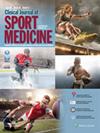Ultrasound-Guided Percutaneous Ultrasonic Tenotomy for Refractory Patellar Tendinopathy in High-Level Athletes: A Case Series.
IF 2.1
3区 医学
Q2 ORTHOPEDICS
引用次数: 0
Abstract
OBJECTIVE To elucidate the clinical outcomes and return-to-sport status of high-level athletes with refractory patellar tendinopathy treated with ultrasound-guided percutaneous ultrasonic tenotomy (PUT). DESIGN Case series study. SETTING Single orthopaedic clinic. PATIENTS Five cases involving 8 knees from athletes (average age: 22 years, range: 17-30 years) who presented with refractory patellar tendinopathy and underwent PUT between 2022 and 2024. Conservative treatments had previously been attempted without sufficient pain relief or return to sports. INTERVENTIONS All patients underwent ultrasound-guided PUT using the TX-2 device from Tenex Health. Jogging was resumed 1 month after surgery, and a return to competitive sports was permitted as early as 3 months postsurgery. MAIN OUTCOME MEASURES Preoperative and postoperative Victorian Institute of Sport Assessment (VISA) scores and Numerical Rating Scale (NRS) scores for pain. Time to return to full training and competitive sports, and presence of postoperative infection signs. RESULTS The VISA score significantly improved from a preoperative average of 43.1 to a postoperative average of 77.1 (P = 0.0004). The NRS significantly decreased from a preoperative average of 6.4 to a postoperative average of 2.8 (P = 0.0005). Four cases involving 6 knees fully returned to sports, with an average return time of 3 months and 19 days (range: 3 months to 4 months and 13 days). One case involving 2 knees did not show sufficient pain improvement and the patient could not return to sports. No signs of infection were observed in any case. CONCLUSIONS PUT for refractory patellar tendinopathy in high-level athletes generally results in favorable treatment outcomes and successful return to sports. This study provides novel insights into the effectiveness of PUT for patellar tendinopathy in athletes, highlighting the need for future studies with larger sample sizes to validate these findings and explore factors associated with poor outcomes.超声引导下经皮超声腱切开术治疗高水平运动员的难治性髌腱病:病例系列。
目的阐明超声引导下经皮超声波腱切开术(PUT)治疗难治性髌腱病的高水平运动员的临床疗效和恢复运动状态.设计病例系列研究.设置单个骨科诊所.患者5例,涉及8个膝盖,均来自2022年至2024年间出现难治性髌腱病并接受PUT治疗的运动员(平均年龄:22岁,范围:17-30岁)。所有患者均在超声引导下使用 Tenex Health 公司的 TX-2 设备进行了 PUT 治疗。术后 1 个月恢复慢跑,术后 3 个月即可恢复竞技运动。主要结果测量术前和术后维多利亚体育研究所评估(VISA)评分和疼痛数字评分量表(NRS)评分。结果VISA评分从术前平均43.1分显著提高到术后平均77.1分(P = 0.0004)。NRS 从术前的平均 6.4 分明显降低到术后的平均 2.8 分(P = 0.0005)。四个病例涉及 6 个膝关节,完全恢复运动,平均恢复时间为 3 个月零 19 天(范围:3 个月至 4 个月零 13 天)。有一个病例涉及 2 个膝盖,疼痛没有得到充分改善,患者无法恢复运动。结论SPUT 治疗高水平运动员的难治性髌腱鞘炎一般都能取得良好的治疗效果,并成功恢复运动。这项研究为了解 PUT 治疗运动员髌腱病的有效性提供了新的视角,强调今后需要进行样本量更大的研究,以验证这些发现并探索与不良结果相关的因素。
本文章由计算机程序翻译,如有差异,请以英文原文为准。
求助全文
约1分钟内获得全文
求助全文
来源期刊
CiteScore
4.70
自引率
7.40%
发文量
185
审稿时长
6-12 weeks
期刊介绍:
Clinical Journal of Sport Medicine is an international refereed journal published for clinicians with a primary interest in sports medicine practice. The journal publishes original research and reviews covering diagnostics, therapeutics, and rehabilitation in healthy and physically challenged individuals of all ages and levels of sport and exercise participation.

 求助内容:
求助内容: 应助结果提醒方式:
应助结果提醒方式:


